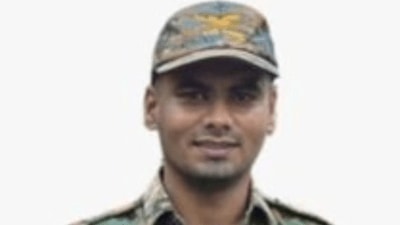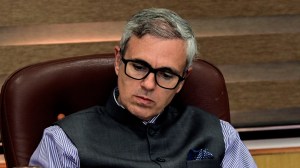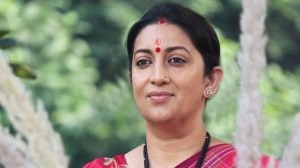Even marketing is an art form. I’ve created a new phenomenon. And I’m not defensive about that: MF Husain
In this second part of a wide-ranging interview on NDTV’s Walk the Talk, painter M.F. Husain tells Shekhar Gupta, Editor-in-Chief of The Indian Express, about his love affair with cinema, his excursions into poetry, his formula for staying young and energetic at 90

In this second part of a wide-ranging interview on NDTV’s Walk the Talk, painter M.F. Husain tells Shekhar Gupta, Editor-in-Chief of The Indian Express, about his love affair with cinema, his excursions into poetry, his formula for staying young and energetic at 90.
• Is some of this scepticism about America coming from recent politics, what Bush has done in Iraq and elsewhere?
Now you have to go into the politics! I don’t pay much attention there, just on the surface I see it, and I think the whole world knows what America is doing. And it is a very sad part in the history of America! But these few individuals come and they’ll go away…
• But America has made great movies!
No. Great movies were made by Italy.
• When is your next film going on floor and what is it going to be about?
I have made a classic in Gajagamini, another a contemporary in The Tale of Two Cities, and the third one I want to make a comedy. A comedy in which you create a sense of humour, a very Indian sense of humour. Not all this political or social satire. Using very few words¿by next summer I think I’ll start shooting, and let’s see if Amrita is available! I have already made a portrait of her and I am working on her image as that of a small town Indian girl.
• Tell us a little bit about the plot.
No. There are so many film makers sitting there…
• OK. So there is Amrita Rao, and who else are you looking at?
There are two girls in the film. Let’s see, I’ve not yet decided. But I’ve written a part of the script.
• Does your fascination for making films start with the way you started — by painting cinema hoardings?
Before that, when I came to Bombay, for nearly 10-15 years I was painting. I had already won a gold medal in portraiture, then I came to Bombay, and because nobody knew me and I had to earn some living, I started painting cinema hoardings. And I was always yearning to become a film maker! And the medium is so expensive. Even my painting that was done in 1955 was a 15 feet long painting in my first national exhibition. It was called Zameen, the earth. It had sections, it was almost cinematic. I had shown the Indian village life.
• I read fascinating stuff about those days in Bombay. How you painted a full cut-out of a female star across a road in Bombay! Durga Khote, a 40 feet cut-out!
I had no place to work, and we lived poorly. In those days, Bombay had trams. They start at 12 and stop at 12. So between 12 midnight to 4 (in the morning) I would put up a huge cut-out on the street… and I finished it.
• And you’ve worked in a dhaba also?
Yes, because when I first came to Bombay my father was also out of job and couldn’t support me. So I said I would work for myself. And I used to sleep on the pavement. Then I started painting hoardings and would be paid 6 annas a day.
• From 6 annas to a million dollars now for a painting, how does it feel?
That what I got then gave me so much happiness and confidence. Today, these are auction houses, with all the auctioneers and dealers doing it. Na aaye ki khushi, na jaaye ka gham; kamaye duniya, khaayen hum! This stage is important in life. Then I was working hard, and now people are working hard to pay for my paintings through their nose.
• But when you hit these figures in crores or millions of dollars for a painting, do you laugh?
I really do! As they say, you always go to the bank laughing! There was a time when art was just limited to religious places. In the 30s-40s it was writers and critics who used to decide. Now it is in the hands of marketing. But the next stage would come to the artists, when only the intrinsic value of the work¿would speak.
• So what do you do with the money?
First of all, I made a film and spent six crores on that. It was all my money. Then I built museums in Delhi, Ahmedabad, Hyderabad and Bangalore. And I gave them to the city, which is a no-profit-making thing. There is a library, a theatre and everything I did, which the government should have done, but I did it because I love it. Then I have six children, and it is a big family, so to make them stable I also have to work there. So this is about the money which has come a hard way, and which goes also the hard way.
• But you have not become a prisoner to money?
I have no bank balance. And I have no inhibitions. Tomorrow if I have nothing, I can sit on the street.
• You have also been a master of marketing
Even marketing is an art form. I’ve created a whole new phenomenon of how to market. And I am not defensive about that. I do market my work. Also, because all these big dealers are now becoming defunct!
• People say Husain is on marketing¿he’ll paint a horse, he’ll walk with bare feet¿it’s all marketing, isn’t it?
There’s nothing wrong with it! But the substance that I am offering, if it was nothing, then it wouldn’t last even ten years.
• Give us the history of your bare feet. How did it start and why?
Whenever you go somewhere, the first thing that catches attention is your footwear. And that becomes decisive of your status. Nonsense! And I am very fond of going to these dhabas and all this because my beginning is like that. And I may be staying in a five star or seven star hotel or be the guest of a maharaja, but early in the morning I go to a dhaba!
• When did you first start this?
Almost 40 years back. I am very fond of poetry, and the poet Mukti Bodh was in a coma for so many months in Delhi then. And he died in the month of May, and I went for the funeral, and there I suddenly thought that he had not even published a single booklet, so neglected he was! I consider him one of the great Hindi poets! And just the feeling came to me that I must also suffer! I took off my shoes and I was walking in May on the tar road¿
• You remember anything of Mukti Bodh?
I don’t remember any lines…
• Can you tell us any of yours, you said you’d been writing poetry?
In my schooldays I used to write in Urdu, but when I came to Bombay I wrote in English¿my collection was published in Geneva, and it is called Poetry to be Seen. There is one I remember that is almost like a landscape — “My words born in you are yet unspoken…” All these lines I wrote to my girlfriend in Czechoslovakia. In 1956 I met her and became very close to her. And I used to write letters to her every day, and there I used to write this poetry…”My words born in you are yet unspoken.”
• So painting, film making, poetry¿what keeps you so young, energetic and vibrant, give us the formula!
Eat less and be always in love, even when you are 90. Somebody said, “There is a woman behind every successful man” and I said “What are you talking? There is a woman behind every successful painting!”
• You say behind every great painting is a woman, and I heard in your studio in Dubai there is another great painting inspired by the new muse in your life, Amrita Rao! Tell us about it…
When I was doing this, she requested that I must also be in the painting…so, here I am, painting her…
• Very well said, Husain sahab! On that note I thank you very much. It was marvellous to have spent time with you! I am so grateful!







- 01
- 02
- 03
- 04
- 05
























